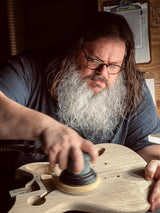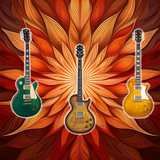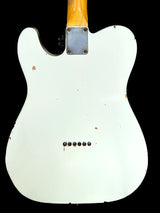What exactly is the Fender Custom Shop division?
There are a lot of misconceptions about Fender Custom Shop guitars. Considering almost 80 years of Fender’s history, Custom Shop as a separate division is still reasonably fresh. In 1985 Fender employees coupled with some investors bought out the company. Created in 1987 to save Fender from bankruptcy, Custom Shop was supposed to become Fender’s Special Forces team. Best of the best were selected for the job starting with two master builders: John Page and Michael Stevens (the story is already beautifully described on the Guitar Magazine website so we won’t rewrite it here). The squad was tasked with creating something stunning to present in 1987’s NAMM show so they started in garage conditions. Funny, how all great projects (be it Apple Computers or James Tyler Guitars) start in a garage, isn’t it? Anyway, the project succeeded and the Fender Custom Shop idea started to bring a substantial profit to the company.
Where is Fender Custom Shop 35 years later? We can think of it as a bit of a different brand, specialized in delivering classic (but not only, sometimes with extraordinary creations) models with your personal choice of features. They create guitars using selected woods, hand-wound pickups, non-standard colors, and finish jobs (think relic). Ordering a Custom Shop Fender guitar you can choose from a really wide array of features for a particular model: neck shapes, pickup combination, wood types you’ve never heard of, and colors only you can imagine. You can check Fender CS Ordering Guide for details

Custom Shop is lightyears ahead of some other boutique brands in terms of brand recognition and respect in the guitar community. The idea of producing fully customized guitars was not new in 1987, in Los Angeles makers like Schecter or Valley Arts Guitars had their workshops offering a high level of customization much earlier. But nowadays, Fender Custom Shop is probably the most-known boutique guitar brand next to Gibson Custom.
How is the Custom Shop quality?
Aside from being great guitar builders, Fender luthiers have one major advantage compared to other companies producing classic-style guitars - knowledge, and contacts gathered during almost 80 years of Fender research and development. It’s a lot of time in the market to learn from mistakes, implement best practices, master instrument-building techniques and have privileged access to first-class woods and top-notch in-house electronics. I can bet that there are things you simply cannot find anywhere else in Fender's warehouses.
Now put this in the light of the modern guitar market - there’s a lot more competition, brand awareness, and “new” players like Suhr, Xotic, Anderson Guitarworks, and James Tyler Guitars. The quality of modern boutique guitars is extremely high (we’re also talking serious money here), and there is not much space for mistakes here.
We’ve tried multiple Custom Shop guitars from the 2000s, including master-built models (Paul Waller, Jason Smith, Denis Galuszka). For sure each one was very different, not always staying close to vintage specs (Postmodern series for example). That’s the thing with Custom Shop guitars - you’d expect them to be very high quality but also the specification of a particular piece doesn’t have to be up to one’s taste. They are (sic!) customized creations, made with a specific customer in mind.

Our personal feeling is that the quality of Custom Shop guitars made in the later 2010s is very high, possibly higher than older ones (from the first decade of the 2000s). Currently produced models are simply stunning and merge top-class craftsmanship with reliable, great materials. Only Fender can produce their original guitars the way they do, with vintage or more modern neck profiles, headstocks, and bodies manufactured to true dimensions. While some parts (like hand-wound pickups made by Josefina Campos or Abigail Ybarra for example) are made especially for Custom Shop and are very expensive or even impossible to find otherwise, Custom Shop also uses generic American Original parts, like bridge blocks or tremolo arms.
The trend of applying aging to new guitars is intense, and it’s more common for Custom Shop guitars nowadays to at least have light aging. Journeyman relic is one common type of relic finish and looks really convincing in currently made Custom Shop guitars. They have this vintage vibe of a guitar that has been taken care of but has 60 years of touring on its shoulders.
What do you get with a Custom Shop guitar?
If you’re not sure what to expect when you open the case of a Fender Custom Shop guitar, here is a summary of what to expect with currently made CS guitars (different accessories and perks changed during the years, so your mileage may vary).

They are a bit different from regular USA-made models, starting from the case itself, with either a yellow, red, or black suede with the Fender Custom shop logo. In the case compartment you will find a few: tremolo arm, bridge ashtray cover, sometimes a strap, stickers, and Fender catalog. Normally guitars with a floating bridge will come with 5 springs, it is common for people to use all of them when they prefer to deck their tremolo, but a two-sided floating setup will most likely use less than 5 so the separate one might be stored in the case compartment. Also, many people forget about the little spring that goes into the tremolo screw-in hole, but oftentimes it’s included to support the tension of the tremolo arm.
The two most important papers that come with your CS guitar will be the Certificate of Authenticity (often referred to as COA) and Floor Shop Traveller. The former is proof that your guitar is a genuine Fender Custom Shop product (and was not stolen for example) and is a piece of hard, cardboard-like gray paper with the model's name, its serial number, and the signature of the Fender Custom Shop director. The latter is a paper containing detailed specifications of your guitar: from the color, pickups, and woods used to the dimensions and special order features. Take your time and learn about your guitar, you will be surprised how many customized features it might have. This is the single most extensive source of information about each particular Custom Shop guitar. Currently, those papers are put together in a leather case but it was not always like this.
The guitar itself
As I stated multiple times before, each Fender Custom Shop guitar is different. There are some important features that you might look out for.

The big part of the guitar’s feeling is the neck: its shape, wood, etc. You can find any profile you imagine, but the modern-C shape is our favorite. Quite slim, yet with definition. We also prefer stripped neck finishes of relic guitars, they seem very smooth and are impregnated so they won’t get damaged over time. We generally like the feeling of a heavily used, satin neck. Of course, if prefer the feeling of a brand new guitar, you can choose Closet Classic (also known as New-Old Stock) guitar with zero relic. There’s also an option to select an ultra-thin (thin-skin) nitrocellulose lacquer, just keep in mind that in some cases when exposed to sunlight the color would change over time. It gives the guitar a unique vibe though as it ages with class!
The headstock will always be the original Fender headstock that is copyrighted and patented. One of the nicest woods you can get for the neck in the Custom Shop is flamed maple, it truly shines like tiger stripes in the sunlight. Fretboard comes in different radii, from old school 7.25” radius to 9.5” more balanced to the often go-to choice of modern players - a compound radius. We would opt for that one (9.5” - 12” is a dream to play).
Then we have the body. The two most common choices are alder (used commonly in Stratocasters) and swamp ash (the first choice when it comes to a Telecaster). There is a popular belief that lighter guitars are more desirable and for some reason, they are simply “better”. While we don’t want to divagate whether it’s true or not, one thing is sure - on average swamp-ash telecasters tend to be a bit heavier than average alder Stratocasters. And in the case of Custom Shop creations you can find relatively light pieces, a thing to look for might be the option “Sort: yes” in the Floor Shop Traveller. As far as we can tell this option relates to a special selection of wood due to its lightweight or visual structure but in many cases that wood is a nice-to-have feature.

As far as pickups go, there are two main configurations: you’ll either have regular Custom Shop pickups (Fender Texas Special, Fender Fat 50s for example) or hand-wound creations from famous Fender winders such as Josefina Campos or Abigail Ybarra or legendary series such as Ancho Poblano. Although regular pickups are very good, we’d suggest getting hand-wound ones if you can.
For the other hardware, Custom Shop uses trusted parts such as vintage or modern keys, 2- or 6-point tremolos, telecaster bridges with 3 or 6 saddles, modern or vintage wiring, capacitors, switches, etc. The number of possible configurations here is pretty much endless. By the way, Fender guys are the actual inventors standing behind many of those features so just go for what rings with your heart.
Best Custom Shop guitar currently?
Of course, Fender Custom Shop can make you any guitar you want. But is there a guitar that you could pick up right off their “shelve” and feel right at home?
There is - it’s a Stratocaster Postmodern Journeyman Relic, which combines both vintage and modern specs. With compound radius, hand-wound Dual Mag pickups it nods towards modern times but keeps the vintage hardware, great wood quality, awesome 1959 D neck profile, and mindblowing journeyman relic finish. Nothing short of a perfect Stratocaster!




